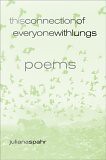this connection of everyone with lungs – Juliana Spahr

I thought that by watching the news more seriously I could be a little less naive. But I gained no sophisticated understanding as I wrote these poems.She admits that she couldn't find answers to her questions or that her answers, if they were that, would only be as satisfying as her observances.
The poem, a wonderful list of the senses, kicks off with a passage about cells dividing. As in any good poem, the rules for its interpretation are provided within the poem, and the opening lines show us clearly where we begin. The smallest structural unit of living matter capable of functioning independently:
There are these things:A fine beginning. Ending with a colon, the first line is a cold, matter-of-fact and, by itself, plain statement about what will follow, a list. The poem then advances to introduce its first image in the second line, cells. They are not simply biological components of living things, they are also containers, jails, spaces. They form the living world, the places and people and things to which we respond and react. This is the shape of the poem, its form, which reflects its things and inhabitants and the whole huge list of the world.
cells, the movement of cells and the division of cells
and then the general beating of circulation
and hands, and body, and feet
and skin that surrounds hands, body, feet.
This is shape,
a shape of blood beating and cells dividing.
But outside of this shape is space.This shape which occupies this space is a living, breathing thing. Every stanza or trope which follows is repeated in its entirety, adding a new image to the end of each, pulling further away until we are actually in space, observing the entire world while we breathe in the poem and the world.
There is space between the hands.
There is space between the hands and space around the hands.
There is space in the room that surrounds the shapes of everyone's hands and body and feet and cells and the beating contained within.
There is space, an uneven space, made by this pattern of bodies.
This space goes in and out of everyone's bodies.
Everyone with lungs breathes the space in and out as everyone with lungs breathes the space between the hands in and out
as everyone with lungs breathes the space between the hands and the space around the hands in and out
The poem shows a controlled use of repetition and list techniques to expose the contradictions of the microcosm of the narrator's life on a tropical island with the macrocosm of the world beyond. It also demonstrates a fantastic use of language and image to emphasize form and build the poem dynamically from the seed of its beginnings. The poem asks us to consider this place, this space we share, and also that those things which often seem so far removed from us must really be considered as parts of us. Parts of our shape and breath.

0 Comments:
Post a Comment
<< Home